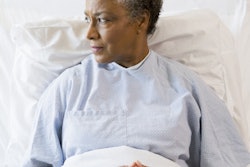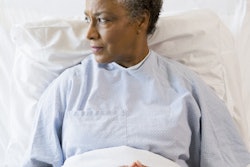
Hispanic, Black, and older women have a higher prevalence of breast arterial calcification (BAC) on mammography, a possible biomarker for coronary artery disease, according to a study published August 27 in the Annals of Epidemiology.
A team led by Guy Montgomery, PhD, from the Icahn School of Medicine at Mount Sinai in New York City also found a lower prevalence of such calcifications among women who have never given birth, premenopausal women, women with dense breasts and breast implants, and women currently using hormone replacement therapy.
"Sharing information about BAC with all BAC-positive women can empower them to discuss their cardiovascular health with a professional, and potentially make changes in their lifestyles that can help reduce risk of cardiovascular concerns in the future," Montgomery told AuntMinnie.com.
Research suggests that of all mammograms performed in the U.S. annually, about 4 million women have BAC. Up to 2 million of these women will "likely" have signs of premature coronary atherosclerotic coronary disease. Previous reports say the prevalence of these calcifications is between 12% and 16%.
Previous studies also indicate that the presence of breast arterial calcifications is "closely associated" with calcification within coronary arteries, which is indicative of the presence of coronary artery disease. Montgomery and colleagues noted that recognizing the presence of BAC and alerting women could help with additional testing, informing preventive cardiology care, and improving women's health.
However, the "vast majority" of prior studies on BAC prevalence either do not report race and ethnicity data or were conducted on predominantly white, non-Latina cohorts. Montgomery added that research on BAC is "relatively new" and current national guidelines don't require their reporting.
Reviewing mammography data, the Montgomery team wanted to assess BAC base rates in a diverse group of women undergoing routine screening mammography. The group also wanted to describe the ties between these calcifications and patient demographics, women's health, and breast-specific factors.
The researchers looked at retrospective data from 17,237 women with an average age of 59.75 years who underwent screening mammography. The average body mass index of the women was 28.61. Out of the total, 12.26% (n = 2,058) had BAC.
| Estimates of breast arterial calcification prevalence by patient demographics | |||
| Demographic | Number | Age-adjusted prevalence (per 10,000) | Adjusted odds ratio (AOR) |
| Other | 4,180 | 1,199.58 | 1.65 |
| Native Hawaiian/Pacific Islander | 33 | 1,179.90 | 1.61 |
| American Indian/Alaskan Native | 73 | 1,091.33 | 1.48 |
| Black | 4,763 | 849.21 | 1.12 |
| Asian | 1,021 | 766.41 | 1.00 |
| White | 6,714 | 763.58 | Reference |
The team also found that Hispanic women had a 2.67-fold increased odds ratio of BAC compared with non-Hispanic women (p < 0.0001).
Along with that, older women had increased odds of calcifications than younger women. With women ages 44 and younger as the reference, women ages 55-64 had 5.98-fold increased odds of BAC. Women ages 65-74 meanwhile had 14.56-fold increased odds.
In what the study authors called "somewhat unexpected," women of Ashkenazi Jewish descent were found to be less likely to have calcifications (odds ratio, 0.28). The team found that 54% of Ashkenazi women in their study had dense breasts, compared with 37% of non-Ashkenazi women (odd ratio, 2.01). However, they added that breast density did not influence the association between Ashkenazi ancestry and BAC in this sample.
Montgomery et al also found several general women's health variables that were tied to BAC. For example, women who had given birth at least once had 2.53 times the odds of having calcifications than women who have never given birth. Postmenopausal women also had an adjusted odds ratio (AOR) of 1.28, and women currently taking hormone replacement therapy had an AOR of 0.26.
"Interestingly, lower than normal [body mass index (BMI)] was associated with higher calcification [prevalence], but not high BMI," the researchers added, writing that the AOR for this was 1.57.
Also, women with breast implants and extremely dense breasts did not have increased odds of calcifications, with AORs of 0.32 and 0.83, respectively.
The study authors touted that the dual function of screening mammography for detecting breast cancer and BAC can be carried out without additional radiation to women. Along with that, mammogram appointments would not take any longer, and assessing calcifications would add "minimal time" to interpretation and reporting by radiologists.
Montgomery told AuntMinnie.com that the team has an ongoing randomized clinical trial funded by the U.S. National Cancer Institute to determine the potential benefits of sharing information about BAC results with women. This includes how BAC information might influence women's cardiovascular health behaviors.
"We hope that our program of research, as well as others across the country, will potentially encourage clinicians and policymakers to provide women with this additional piece of health information," Montgomery said.




















